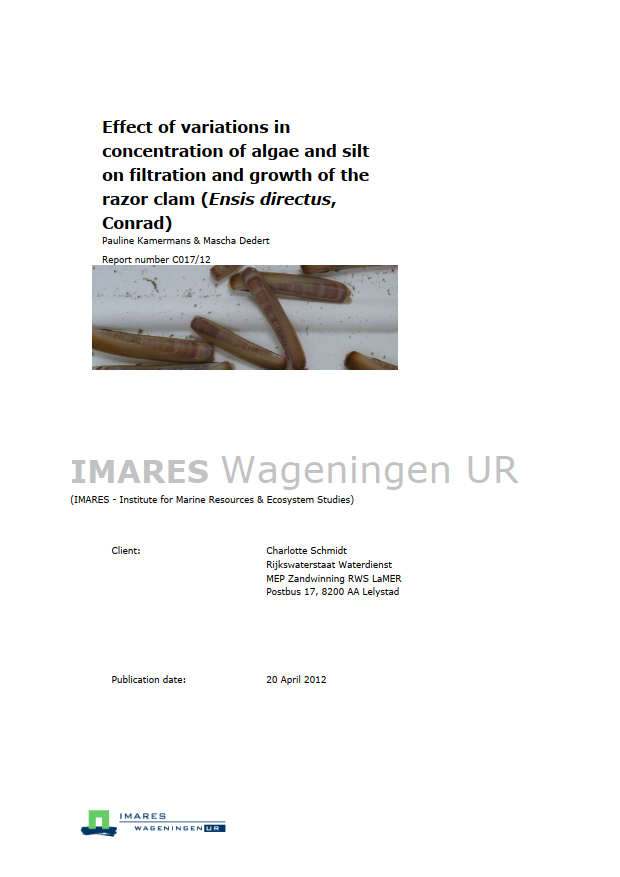Kamermans & Dedert 2012. Effect of variations in concentration of algae and silt on filtration and growth of the razor clam (Ensis directus, Conrad).
As part of a collaboration between the research programme Knowledge for Primary Processes Silt of Rijkswaterstaat Waterdienst NWOB (department of Infrastructure and Environment, MinIenM, RWS) and the Monitoring programme Sand extraction RWS and the LaMER Foundation, RWS-WD NWOB requested further research into the relation between food availability and Ensis production. The aim is to better understand the effect of different algae and silt concentrations on filtration and growth rates and improve prediction of effects. Laboratory experiments were carried out with Ensis directus to estimate food intake rate and growth rate as a function of food density and clam size. Growth experiments carried out in 2010 showed that the species seems to be very fragile as shown by the low growth rates and high mortality rates. Improvements designed to optimize the experimental conditions, survival rates and experimental set-up were implemented in 2011. These were: experimental animals were collected with a box corer instead of a suction dredge; animals were kept in cylinders without sediment, but their shells were closed with elastic bands during the filtration experiments; circular tanks were used with increased water movement; the diet during the growth experiment consisted of two species of algae. Two food levels were tested: low food availability (6.5 µg Chla/l) and high food availability (16.5 µg Chla/l) at four silt concentrations (0, 50, 150 and 300 mg/l). Only the highest silt concentration induced a reduction in filtration rate. Food level did not influence filtration rate of Ensis, but intake rate is higher at the high food concentration, because more algal cells are present in a certain volume of water. Longterm (10 weeks) exposure to silt concentrations of 300 mg/l showed significantly higher growth than the 150 mg/l treatment indicating that exposure to a high silt concentration did not induce a reduction in growth. Long-term (10 weeks) exposure to a food level of 6.5 ug chla per liter reduced shell growth of Ensis compared to growth at 16.5 ug chla per liter. The filtration and growth rate results are used in a modelling study on growth and condition of Ensis during sand extraction 2013-2017 (Schellekens, in prep). The conclusions of this study give more notion of the effects of sand extraction in the coastal zone of the North Sea on the viability of the razor clam Ensis directus. Sand extraction always goes together with an increase of silt concentration in the water column. This reduces the light conditions for algal growth which reduces the food availability for Ensis. The laboratory experiments suggest that Ensis is more sensitive to a reduction in algal concentration than to an increase in silt concentration. Some discussion is given on the implications of the results for the management of sand extraction.

